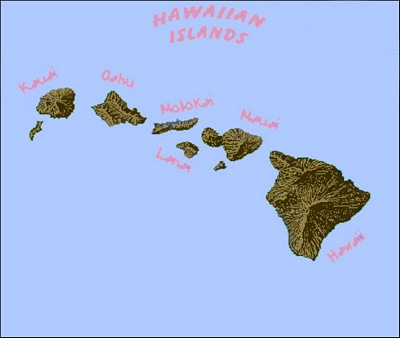
In pronouncing Hawaiian words, vowels marked with macrons, short horizontal
lines, are usually stressed. However, we suggest putting equal emphasis on all
syllables until you become more familiar with the subtle differences in the
language.
The glottal stop ' is a stop consonant. It is made by closing the glottis so
tightly that no air can pass through, causing a momentary interruption in
speech. One example of a glottal stop is that made in pronouncing the expression
''oh-oh! ''
In the names that follow, diagonal lines indicate glottal stops, and dashes
join syllables. The letter combination ''au'' should be pronounced to rhyme with
the word ''now.''
Points of Interest in the Hawaiian Islands
Kaua'i (Kau-ah/ee)

Kalalau
Valley (Kah-lah-lau)
Uninhabited, this vast, rugged valley is virtually
impossible to reach, except by sea or air.

Fern Grotto
This secluded
cave is reached by boat on the Wailua River. Giant ferns, nourished by an
80-foot waterfall, grow upside down and hang at the entrance.

Waimea
Canyon (Why-may-ah)
Called the ''Grand Canyon of the Pacific'' by Mark Twain,
the canyon's beautiful colors change, depending on the time of day.

Lumaha'i Beach (Loo-mah-hah/ee)
One of the most beautiful
beaches in Hawaii, it was used in the movie South Pacific.
Ni'ihau (Nee/ee-hau)
Just twenty miles off the west coast of Kaua'i, travel to this
privately-owned island was once restricted. Inhabited by only about 200 people,
the locals have managed to preserve the traditional Hawaiian language and
culture.
O'ahu (Oh/ah-who)
Diamond Head
In the early
1800s, this extinct volcanic crater and familiar Hawaiian landmark was given its
name by British soldiers who mistook calcite crystals they found there to be
diamonds.

Hanauma Bay (Hah-nau-mah)
This beautiful cove was created when
the sea broke through a wall of an extinct volcanic crater.

'Iolani
Palace (Ee-oh-lah-nee)
The only royal palace in United States, the residence was
built by King Kalakaua, brother of Hawai'i's last monarch, Queen
Lili'uokalani.

Kamehameha I Statue (Kah-may-hah-may-hah)
Draped
with long flower leis on Kamehameha Day, June 11
th, the
statue honors Hawai'i's first ruler, Kamehameha the Great.

U.S.S. Arizona
Monument
The floating memorial is built over the sunken battleship, U.S.S.
Arizona. The ship entombs over 1,000 servicemen who lost their lives on December
7, 1941, when Japanese attacked Pearl Harbor.

Nu'uanu Pali Lookout
(New/oo-ah-new Pah-lee)
The site of a bloody battle in 1795 won by Kamehameha l
and his men. Thousands of defeated warriors jumped or were pushed to their
deaths on the rocks below.

Punchbowl
Situated on the floor of an extinct volcano, the National
Memorial Cemetery of the Pacific is the final resting place for more than 20,000
members of the armed forces.
Moloka'i (Moh-low-kah/ee)

Kalaupapa (Kah-lau-pah-pah)
A tiny, isolated peninsula that was made famous
by Father Damien, a Belgian priest who came in 1873 to help treat victims of
Hansen's Disease or leprosy.

Kapuaiwa Grove (Kah-pooh-ah-ee-vah) Over 1,000
coconut trees were planted here in the 1860's by Kamehameha V.
Lana'i (Lah-nah/ee)

Nearly all residents on Lana'i are engaged in growing and harvesting
pineapple, one of Hawaiian most important crops.
Maui (Mau-ee)

Lahaina (Lah-high-nah)
A historic town, famous for its missions
established by New England ministers and widely known as a whaling center in the
1800s.

Haleakala Crater (Hah-lay-ah-kah-lah)
Designated as a National Park, this
dormant volcano measures twenty-one miles in circumference. The House of the Sun
observatory is situated on the rim of the crater.

'Iao Needle (Ee-au)
This
moss-covered spire, which rises 2,250 feet, is located in 'Iao Valley State
Park.
Kaho'olawe (Kah-hoe/oh-lah-vay)
The smallest island
in the Hawaiian chain, Kaho'olawe was once used for bombarding and target
practice by the U.S. Army and Navy.
Hawai'i (Hah-wah/ee)

Mauna Kea (Mau-nah Kay-ah)
A dormant volcano, which is
snow-capped in winter and popular for skiing, rises 13,796 feet above sea level,
and it's the state's tallest peak.

City of Refuge National Historical Park
In
ancient times, political and religious asylum was granted to anyone who could
reach its grounds.

'Akaka Falls (Ah-kah-kah)
Located in 'Akaka Falls State Park,
this waterfall plunges more than 400 feet over a volcanic cliff.

Kilauea Crater
(Key-lau-way-ah)
This steaming, active volcano is located in the Hawai'i
Volcanoes National Park, and the Hawai'i Volcano Observatory is located on the
crater's rim.

Black Sands Beach
Formed by volcanic action, lava is ground into
grains of black sand by the surf.